* Since publication of this post, my research into the form, flour, and tools of the trade in relation to the Panis Quadratus bread remains of Pompeii has been updated significantly and is available to read in The Bloomsbury Handbook of Experimental Approaches to Roman Archaeology. *
Salvete Pistores! Good day from Rome! I hope you like Roman bread recipes and rabbit holes because we’re about to go down a deep one. It’s time to revisit the Panis Quadratus, the Pompeian bread that has been represented so beautifully and frequently in the archaeological records at Pompeii and Herculaneum.
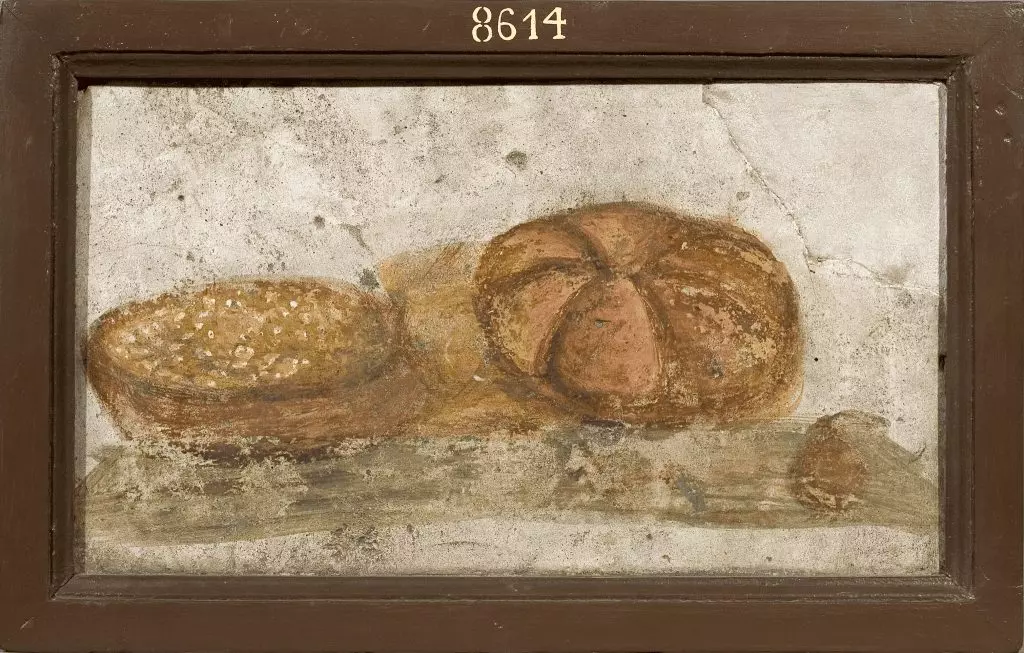
Most of us at some point in our lives have seen images of these iconic loaves of ancient Roman bread as they were represented in frescoes or as artefactual evidence itself at the 2,000-year-old Roman town of Pompeii. In 1862, 81 of these circular loaves were excavated from a large industrial oven at the Bakery of Modestus at the site and since then these beautiful examples of ancient food preparation and food culture have intrigued bakers, archaeologists and food historians alike.
When I published my first article and interpretation for a Panis Quadratus recipe in September of 2017 here on Tavola Mediterranea, the response was overwhelming and wonderful. Readers from all corners of the web and all areas of culinary and academic backgrounds chimed in to offer their thoughts and theories on how this iconic bread was made and which kitchen implements may have been used to create its intriguing and unusual form. What was the loaf made of? Why was the loaf sectioned into 8 or more pieces? What tools were used to create its forms and features? These questions prompted conversations on sites such as Hacker News and on the Tavola Facebook page, and via email and comments on the original post’s page. This topic and some of my work was then featured on Atlas Obscura and on Simon Morton’s ‘This Way Up‘ (RNZ) after the initial article was circulated online. The overall response prompted me to do some further research and experimentation in an attempt to try to get closer to understanding the process that went into making this stunning bread and recreating it as true to its original form as possible. But it wasn’t easy. This recent process of research and experimentation has been a veritable bread-nerd rabbit hole, a process that depleted wheat supplies in the state of California, and a process that saw an army of bread overtake my home like a scene out of Mother! This process also allowed me to understand how the ingredients behaved with water and starter, how these loaves may have been formed, and how these loaves could have been made efficiently and in high volume during the height of the Empire. This article will delve into some of my new research, experimentation, ideas and theories and will quite possibly take us one step closer to understanding how the Panis Quadratus (or Panis Siligineus) was made and what tools and ingredients were used to make it. So, if you’d like to go down this rabbit hole with me, get some grain from your horreum and pour yourself a nice mug of mulsum,… but before we begin here’s a bit of history and context:
Barley and bread wheat (Triticum Aestivum) were the two most frequently used grains in Greek and Roman cooking with barley yielding almost 9 times more supply than wheat itself making wheat somewhat of a luxury grain. While the Roman province of Egypt was the prime supplier of wheat to the Empire for many years, wheat was also being shipped in to Rome and its surrounding settlements from Pontus and Sicily.
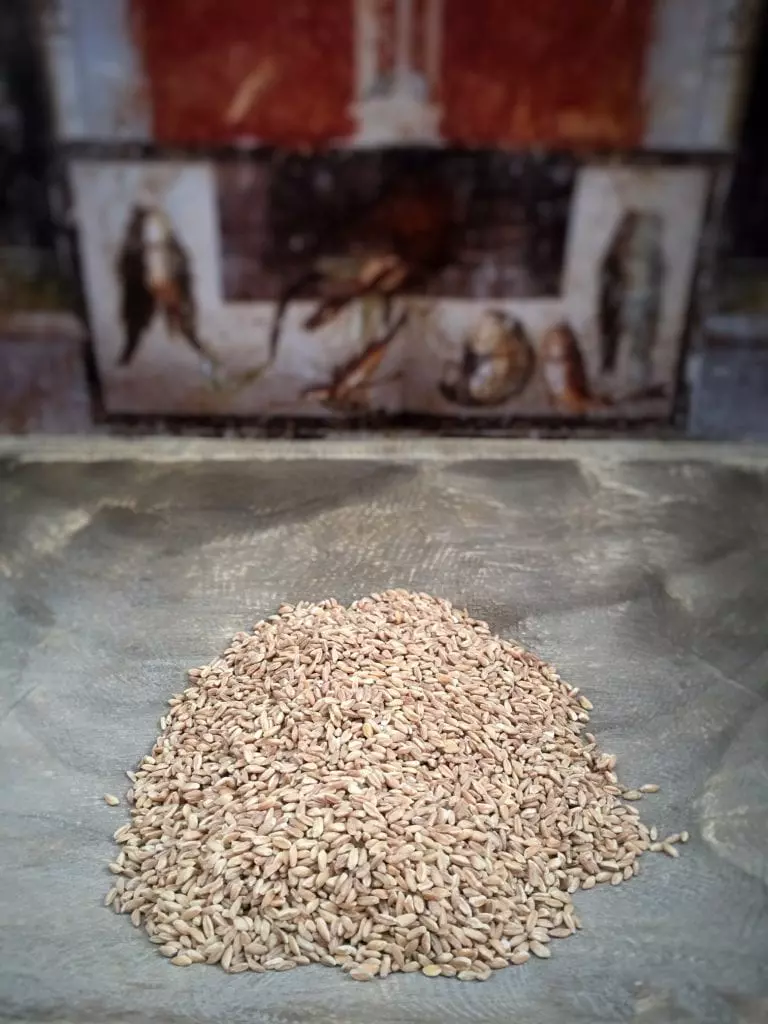
Professional bakers in Rome, and in Pompeii, did not exist until the 2nd century BC and it is suggested that this advancement in specialized crafts has everything to do with the appropriation of Macedonia for the Republic by Aemilius Paulus. It is also suggested that Pliny the Elder’s reference to Greek knowledge of leaven indicates that yeast likely became a component of Roman bread-making during this time as Greek bakers were employed in Roman settings: “The Greeks have established a rule that for a modius of meal eight ounces of leaven is enough.” (Pliny the Elder, Historia Naturalis – Book XVIII-26(11)). This also suggests that the advent of leavened bread-making by the Romans in the 2nd century, despite the feelings of disgust or impurity that ‘putrefied and rotten dough’ invoked in many, brought bread to a whole new level of social and dietary significance.
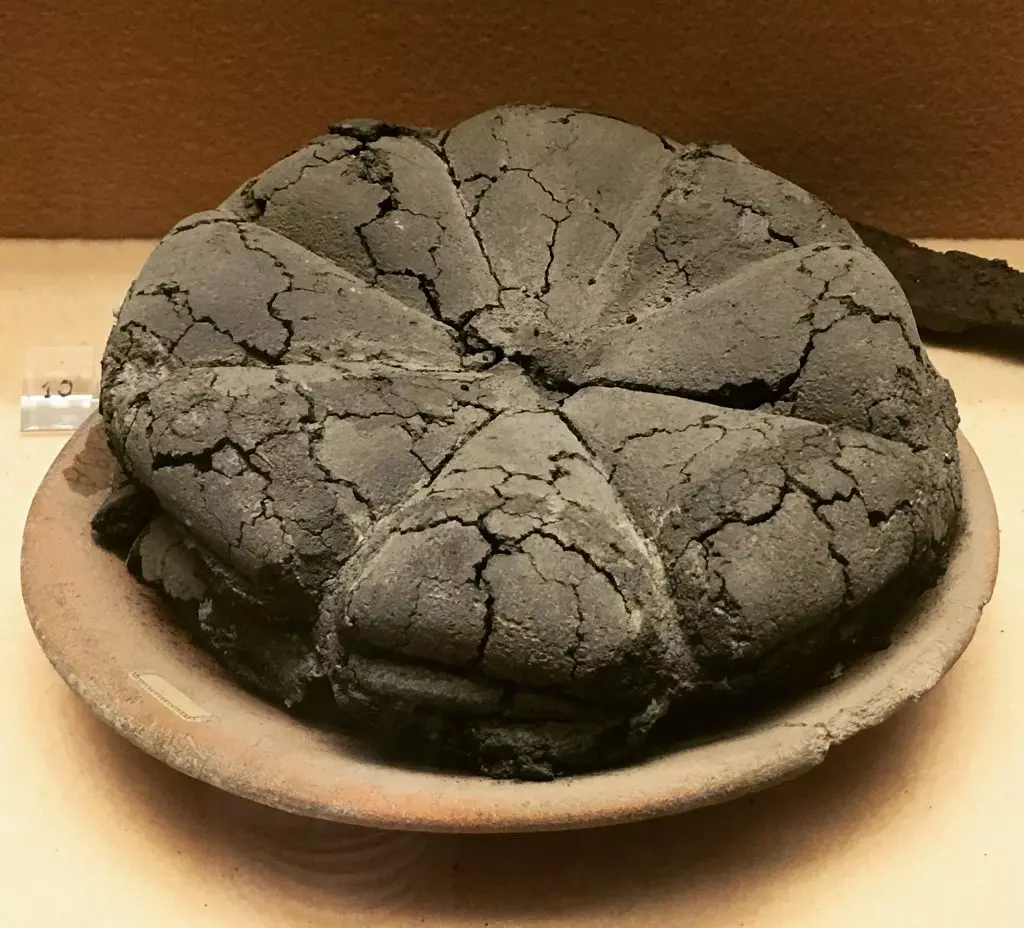
At this critical point in Roman history, bread was the backbone of the Roman daily diet. Commercial bread-baking began to emerge and the role of baking meager flat-breads on the home hearth moved from the hands of women in the household into the hands of the men who ran commercial bakeries. These commercial bread bakers (pistores) were powerful men in Roman society; and the bakeries themselves are incredibly telling and sensory environments. Bread required massive quantities of wheat, fire-wood, and slave and animal labour to produce a daily supply to feed approximately 12,000 people. Donkeys walked in circles tirelessly, for hours on end, rotating the industrial sized quern-stones (grain-mills) that ground the wheat; slaves did the same if animal labour was not possible. A kneading apparatus was also employed that featured rotated wooden bars that paddled dough just like our modern Kitchen-Aid mixers do only with human or animal strength to power it. The ovens were fired from dusk until dawn and enough grain had to be imported from within the region or from provincially confiscated territories to supply the Roman people with their daily bread. Bread was prepared daily, in high volume, sometimes in the home but mostly in commercial bakeries run by a Corpus Pistorum (or Collegium Pistorum): a veritable trade-union of powerful bakers who were likely looked upon as a Roman version of the ‘Hoffa teamsters’ of the day. The men who controlled the bread and the commercial ovens often ran for office or influenced civic elections themselves. A common saying of the day was to say that a baker ‘gave good bread’, ‘bonum panem fert’, which meant that he could be a trusted community member or a potential civic official.
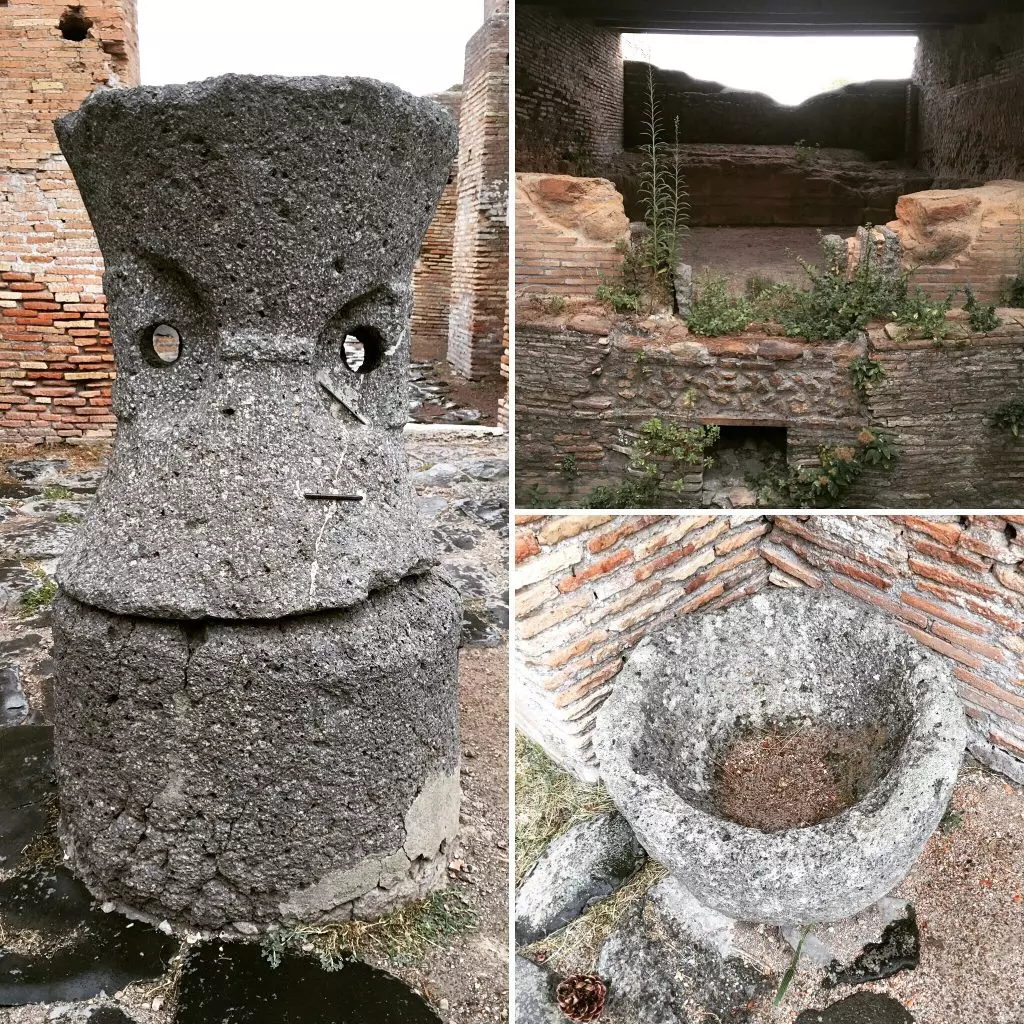
To understand the power that bakers once held in Imperial Rome, all one has to do is stand in the shadow of the enormous tomb of master baker, Marcus Vergilius Eurysaces, that was erected outside of Porta Maggiore in Rome during the 1st century BC. The monument, which is often touted as being garish and overdone, is a beautifully rendered structure that visually and textually summarizes the accomplishments of a respected Roman baker and his baking enterprises. The construction materials used to build the monument also incorporates actual circular bread-kneading bins as a part of the structure. At the top of the structure is an epitaph that reads as follows: ‘Est hoc monimentum Marcei Vergilei Eurysacis pistoris, redemptoris, apparet’ which translates into English as: ‘This is the tomb of Marcus Vergilius Eurysaces, baker, contractor, it’s obvious!’. In addition to the epitaph, a band of marble reliefs line the top of the structure that beautifully demonstrates the stages of Roman bread production in a commercial bakery setting.
Archaeological Evidence
Turning now to the beautiful Roman resort town of Pompeii, let’s explore some of the archaeological evidence for making Panis Quadratus in this setting. In 1862, the Bakery of Modestus was excavated under Guiseppe Fiorelli and produced 81 intact and semi-intact loaves of bread that were abandoned in situ in a large oven when the original bakers fled the bakery, and the town itself, during the eruption of Mount Vesuvius in 79 AD. 76 of these 81 loaves were the circular, 8-wedged variety that we see frequently on display in the museums and in publications about the site.
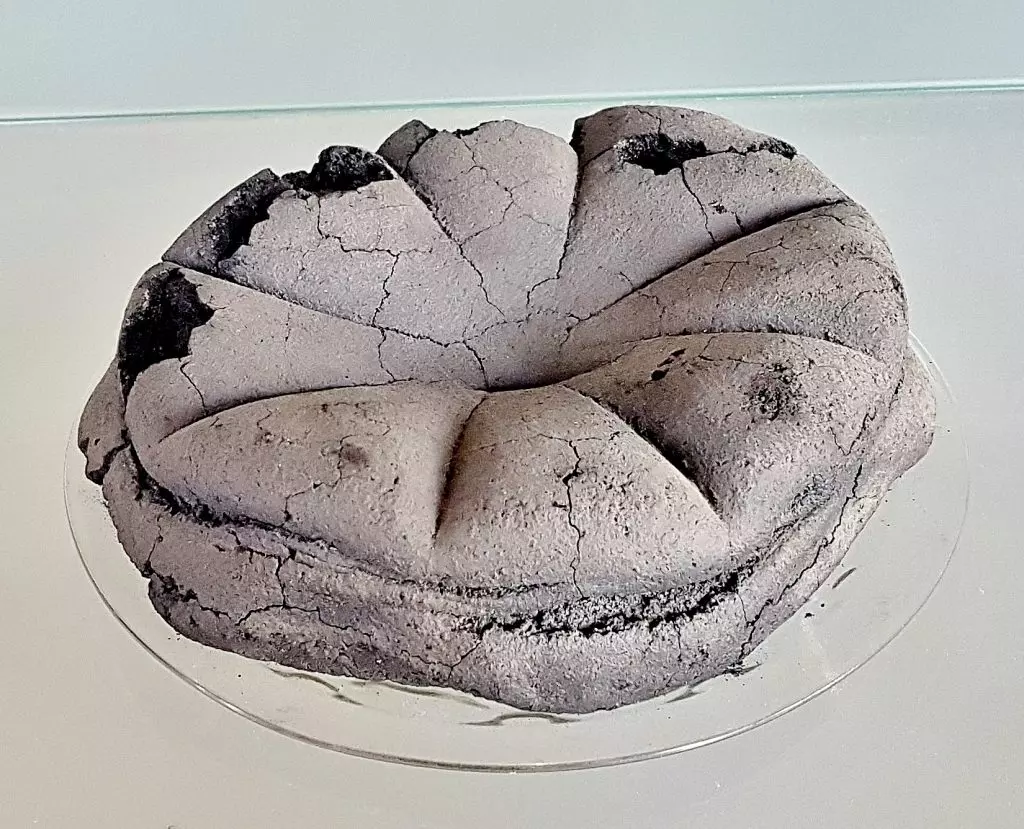
De Luca (1863) conducted an in-depth study of the loaves and some of the finds at The Bakery of Modestus and notes that the wedge divisions on the top of the loaf are relatively even in relation to each other, they’re convex, and the divisions between them were created by ‘something sharp’ and with the application of pressure. De Luca also remarks that a central ‘sag’ is common in the loaves with a hole-like indentation that is not perfectly circular or centred. He suggests that the horizontal rim around the external edge was created with several slashes of a knife as he felt that that contour was not even or created with one single motion. De Luca also notes that the exterior of the bread is a darker ‘brown’ with the inside crumb appearing to be lighter in tone. The density of the crumb is also less than the crust demonstrating some cavities in the crumb than can be found in leavened breads. The loaves, on average, measured 20 cm in diameter but fluctuated, due to composition, oven-spring, or spreading, anywhere from 18 cm to 22 cm (7 inches – 8 2/3 inches).
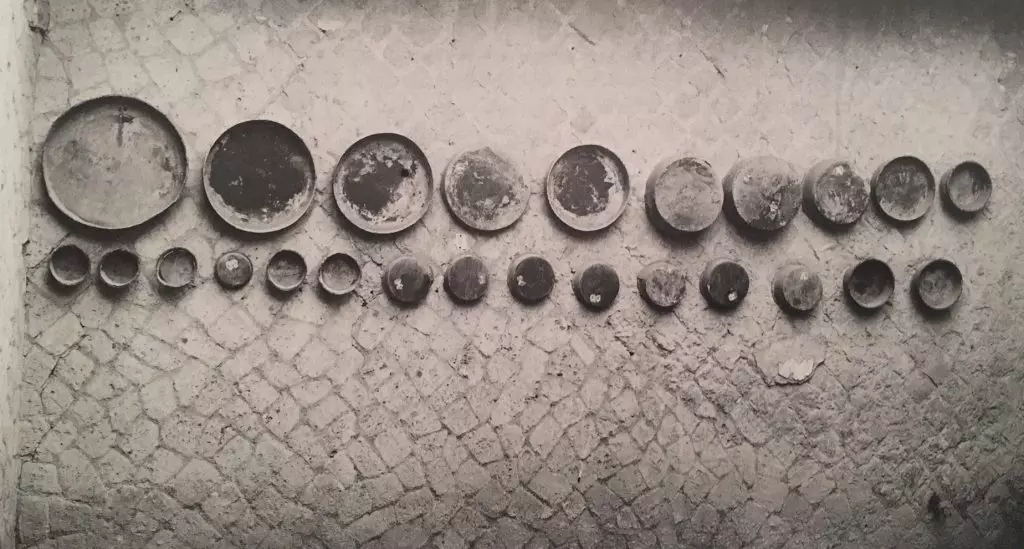
Complementing some of this form-related archaeological data at Pompeii in a very useful way are a group of 25 bronze pans that were found in situ in the Bakery of Sextus Patulcius Felix at Herculaneum. Judging by their sizes and location in a pistrinum at the 2,000-year-old site that is located fifteen kilometres north of Pompeii. These pans were interpreted as being pans that were used for forming bread and pastries, not for baking them, by Amedeo Maiuri (1958). This interpretation is also supported by the fact that the loaves excavated at The Bakery of Modestus were not found to have been baking in pans in the oven that they were excavated from but rather were found resting on the oven floor.
De Luca (1863) also records that on August 7th, a small grain mill was excavated at the Bakery of Modestus that contained a large amount of unmilled grain. Physical (visual) and chemical analysis of the carbonized grains revealed that all of the grain found in this mill was ordinary bread wheat (triticum aestivum). This wheat was often milled and sieved several times, refining it to a delicate, fine flour that was called ‘siligo’, thus the other name often used when referring to this bread: panis siligineus.
On a side note, the term ‘Panis Quadratus‘ is the most commonly used term for this bread when referred to in English. It wasn’t fabricated by academics or classicists, though; it is derived from a quote by Atheneus: “Seleucus (fr. 40 Müller) says that warm bread crumbled into liquid is called blema. Philemon says in Book I of A Complete List of Sacrificial Offerings that purnos is the name for bread that is made from unsifted flour and contains all parts of the grain; he also reports that incised loaves, which the Romans refer to as kodratoi, are called blomiaioi, and that brammite is the term for bran bread, which Amerias (p. 10 Hoffmann) and Timachidas (fr. 26 Blinkenberg) call eukonos . Philetas in his Miscellany (fr. 11 Dettori) reports that spodeus is the name of a type of bread consumed only by one’s relatives.” (Athenaeus, The Learned Banqueters. 114.e). Some readers may consider the name to be confusing, as the loaf is cut into 8 sections, but if you consider that those eight sections could be created by four long linear divisions, created from end to end of the loaf edge (travelling straight though the centre node), you’re then looking at four lines, not eight.
So doesn’t this data give us a bit more to work with? I’d say we should offer a libum to Ceres in thanks but we don’t have time; we have lots of wheat to mill. So with this additional information and some good old-fashioned experimentation, let’s see if we can move a bit closer to making this loaf as true to form through experimentation and further interpretation! It’s time to strap the donkey to the quern-stone, roll up our toga sleeves and see what we can arrive at with this new information. Some of the implements used in this experiment may not be readily available to most but feel free to improvise if you decide to follow along. Here’s what you’re going to need:
Baking Bread with the Romans: Part III – The Panis Strikes Back
Note: this recipe is inspired by the research of the author and is developed for a non-academic, lay readership. It does not reflect the ingredient quantities or ratios proposed by the author in her academic publications.
Ingredients (for two loaves)
- 1650 g (13 cups) of whole wheat flour (hand-milled or store-bought)
- 990 g (1 L) of tepid water
- 100 g (1/2 cup) of bread starter*
- salt as desired
Implements
- Flour sieve
- Large mixing bowl
- Large cotton tea towel
- 2 shallow 8” (20 cm) circular baking pans
- Baking or gardening twine
- Parchment paper
- Cooking scale
- A thin dowel or an 8” (20 cm) circular wooden wheel
- Optional: A ceramic baking cloche or a custom testa. You can also use a dutch oven if you use parchment paper below the bread during its final rise. You may also use a pizza stone or large baking sheet.
*The hydration of your bread starter may affect the hydration of your dough. Your end goal is to achieve a large ball of dough that is firm but workable; Not too dry as to crack or rupture when rising but not too wet or tacky as to spread too much during the proofing process. Here is a recipe for Pliny the Elder’s levain, or bread starter, if you’d like to make your own.
Note: We’re going to do some of this by weight, including weighing the dough prior to shaping as you would in a modern commercial bakery. This choice was made as it was highly likely that these loaves were a controlled product and were likely weighed before sale as well as before baking in order to keep their sizes as uniform as possible for yield and distribution accuracy.
Preparation
- Begin preparing your dough by mixing the starter in with the tepid water until it is fully dissolved.
- Sieve your flour, hand-milled or otherwise. Use the exact amount indicated above as your refined flour component in the dough.
- Add the flour and salt and to the mixture and begin mixing your bread dough. If the pistores used a kneading machine, you go ahead and power up that Kitchen-Aid mixer if you want to sip your mulsum with your other hand! You may also take an old-school approach and use a donkey and a plank of wood… or your hands. Again, depending on the coarseness of your flour and the hydration of your starter, assess the dough as you go and add water or flour as needed to obtain a workable ball of dough that is not too sticky or too dry.
- Cover your mixing bowl with a damp tea towel (ring the water out well) and let the dough stand until it doubles or triples in size. This time will vary depending on the temperature of your kitchen and its humidity levels.
Once the dough has risen, retrieve your cooking scale and your 8” baking pans. Here’s where things get interesting. At this stage I decided to experiment with how much dough would fit nicely into the size of a proofing pan that has a lip that is equal in diameter to the average panis quadratus loaf. I considered that the pistores in the Roman bakeries likely weighed their bread to maintain a consistent size and output when making these loaves, especially considering the fact that the loaves were often weighed before distribution. Beginning with one Roman pound of dough, which is equivalent to 329 grams, I began pulling dough from my mixing bowl and weighing it until I had an amount in on my scale that looked like it could sit inside the 8” pan (De Luca’s 20 cm average diameter) with enough room to expand, both towards the sides of the pan and slightly over the upper lip. This amount turned out to be an even 4 Roman pounds of dough per loaf which equates to 1kg and 316 grams, or 1316 grams. This recipe provides for enough quantities to make 2 loaves which each call for approximately 1316 grams of dough.
Dust a clean work surface with some flour. Flip one of the pans over and hold it slightly above your dusted work surface until it falls out onto the table. Dust the upper surface of the loaf lightly with flour. Here’s where things are going to get interesting again: we are going to create the pointed wedges on the top of the loaf known in Italian as the ‘otto spicchi’. Upon closer observation, it is clear that the grooves that create the eight wedges on the top of the panis quadratus are not knife slashes in the top of the dough, as previously thought. These are impressions in the dough. If we look closer at the inside of the grooves that separate each of the eight wedges, we can see that they’re slightly curved downwards and appear to have been made with a blunt, not sharp instrument. De Luca’s assertion is not entirely accurate, nor was my initial interpretation of these divisions in September of 2017. Making these impressions with the back of a knife would have also been dangerous, especially if you were pivoting it from the centre outwards, so consider this when you choose your tool to make the wedge formations. I had something completely different in mind when I decided to approach the form and fabrication of this iconic loaf once more: I had a wooden wheel custom made for me with thin spokes that creates blunt, linear, and rounded grooves between the wedges and also creates a centre depression where the cog of the wheel sits. I pressed this wheel into the top of my loaf prior to baking and then used my finger to create the depression in the centre of the loaf where the cog impression was visible. Did the Roman pistores use discarded wagon wheels or custom made wheels to stamp their bread? A wooden, wheel-like implement made a lot of sense to me considering that any tool of this kind would have been burnt at Pompeii, and thus eliminated from the archaeological record. A wheel-like tool would have also created an even distribution pattern between the wedges, as De Luca observed. It also created an outer rim along the horizontal edge of the loaf. This seemed to me to be the most likely tool that was used to create the otto spicchi but I could not figure out why they chose this form, what inspired it, and where they got the device… until I met Franco Tella, and classical archaeologist working with MiBACT in Rome. Franco and I met at Ostia Antica weeks after I had conducted these experiments and we had a long conversation in front of the Grandi Horrea (grain store-houses) in the heart of the ruins of the ancient Roman port town. Tella explained that the horrea were situated in close proximity to the bakery at Ostia in order to facilitate the milling of flour. Grain and flour was moved back and forth between the two buildings by either slaves or by a small wagon called a ‘carrus’. He showed me the photo of a carrus that was rebuilt based on one that was excavated at Ostia Antica and I immediately looked at the wagon and examined its features. Small wooden wagon. Small wooden wheels. Eight wooden spokes.
Perhaps this wheel was inspiration for the bakers? Perhaps the image on the bread was symbolic of the wheel and the industry? It’s not too far-fetched an idea when you consider that in the 2nd century CE, Roman grammarian, Sextus Pompeius Festus (De verborum significatione, XVII:9), describes the panis quadratus loaves as being shaped like a wheel and used in a ritual capacity during the festival of Summanalia. Perhaps discarded or broken carrus wheels were used to create the impressions on the panis loaves? We can’t be too sure until I can measure the wheels of the carrus but it certainly got my blood pumping when I saw the wooden wagon and understood its use at the bakery at Ostia Antica. I was one happy little bread-nerd indeed. Now, I understand that no one at home will have a custom-made wooden wheel like mine (yet) so take a device that is accessible to you to create the divisions in the top of the loaf be it a thin dowel, a thin pencil, or something else that is linear, thin and blunt. Make the sections even and the depth the same from groove to groove.
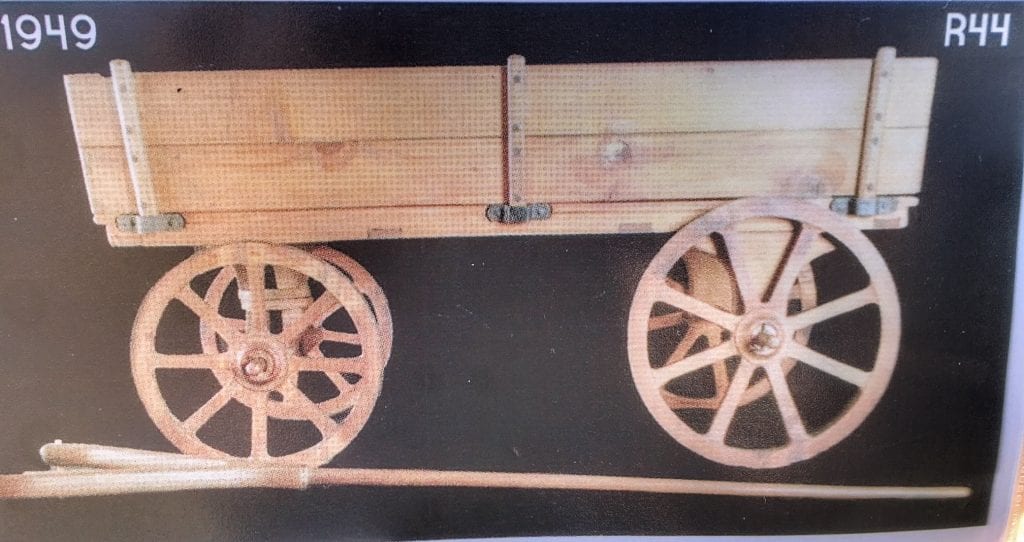
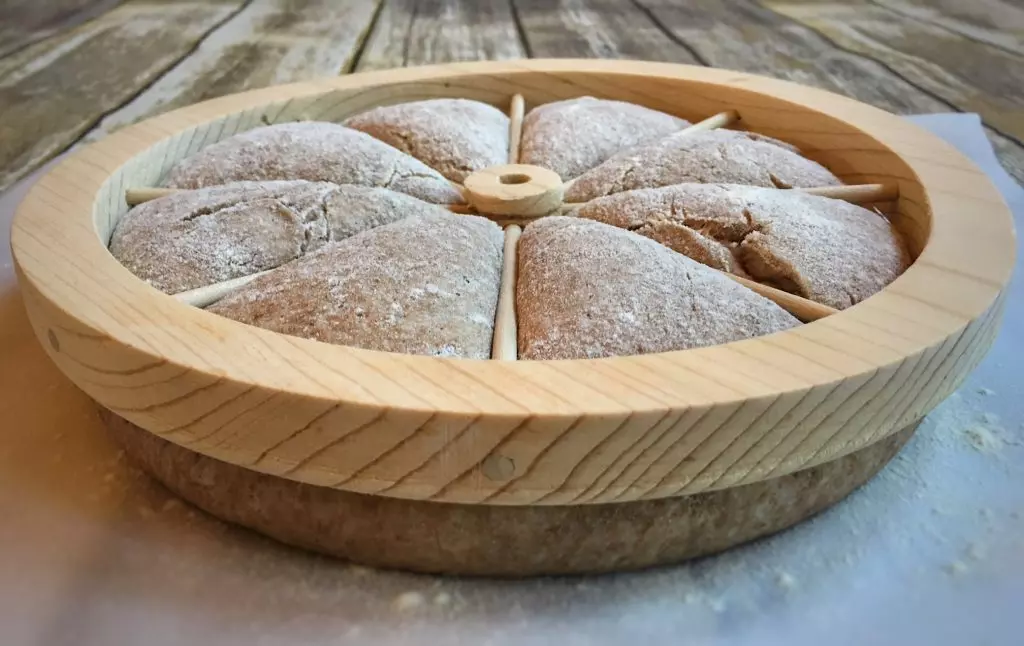
Now, we arrive at the part of this experiment/recipe that will cause the internet to collapse in on itself and some academics and food writers to become very cranky. I stand behind the theory that a ‘spread restrictor’ was used on the horizontal waist-line of the bread. Why? Because it works and it provided results that were similar to the carbonized loaves that were found at Pompeii. Was it twine? A ring? A band of some sort? Who knows…. But something created that severe indentation and spreading did not occur during baking. The bread dough for this experiment was dense and of low hydration (approximately 55%) which allowed the dough to be malleable but to also hold its form while baking, as the loaves did at Pompeii while they were being ‘incinerated’. What did not hold, however, was a horizontal groove when it was created by a knife or by the bottom, rounded inner edge of the wooden wheel after it was pressed into the formed dough. Spreading occurred each time and the loaf expanded outwards during the baking period (oven-spring) almost eliminating any indication of a horizontal groove around the waist of the loaf. So I used a restrictor again. You can too. I used heavy, untreated garden twine and gently tied it around the loaf prior to baking.
Conclusion
Revisiting the recipe for Panis Quadratus, its form and fabrication was a wonderful experience. Finding additional data regarding fabrication was helpful in narrowing down how much materials to use and how to prepare it all. The form, yet again, remains somewhat of a mystery but is less elusive than it was before. I believe that the theories of a wheel-like tool for creating the eight wedges and a horizontal ‘spread restrictor’ has validity. The eight wedges on the top of the loaf were likely formed to be broken apart easily and used as an ‘edible eating utensil’ for sopping up stews, soups and pulses. But what functional purpose could the horizontal groove serve other than being evidence of a horizontal restriction of some sort? The loaves were not ripped apart horizontally and there are no wedge separations on the bottom of the loaf; this loaf isn’t two halves, one on top of the other. The groove along the waist-line appears to serve no purpose other than being residual evidence of spread-control that was implemented in order to preserve oven floor space during baking and to keep all loaves a uniform size. It is uncertain as to how it was made, however, as the grooves are not as defined on the waist-line as the divisions on the top of the loaf.
The centre depression and the sag in the middle of the panis also remains a mystery. The impression of a wheel cog does not really translate well but pushing it down with an index finger makes that depression appear deep and off-centre as most of the centre depressions appear on the excavated loaves. The sag is difficult to achieve unless the loaf is very flat and pressure is applied from the centre pushing the wedge edges upwards and outwards. Again, baking and oven-spring may also push the centre straight up once again as it did the sides without restriction.
If there’s one definitive conclusion that can be made from exploring this bread once again its that this loaf of bread seems to remain one of the greatest mysteries in the Roman archaeological record. Just when you think you’ve got it all figured out… the panis strikes back. But we won’t give up, will we? No. We are not quitters. Therefore, I will be going into the laboratory at the Naples National Archaeological Museum this autumn to study these loaves up close and personal. Another step closer, once again, to understanding the pride of the Roman table. Stay tuned! This saga will continue…
Acknowledgements: Thank you to Drs. Ken Albala, Scott Stull and Profs. David Mattingly and Penelope Allison for throwing ideas around with me, for letting me rattle on and on about this bread via phone and email, and for aiding me in my research.
If you would like to acquire one of the wooden wheels that were used for this experiment, it can be purchased in the Tavola Shop.
Feel free to leave comments or suggestions about this article using the comment form below. Did you try this recipe? If so, feel free to join the discussion and post photos on Tavola’s Facebook page.
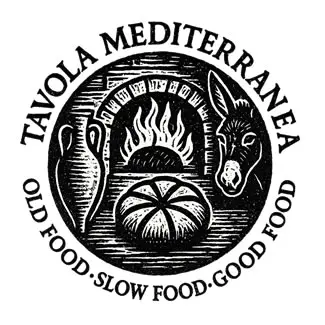
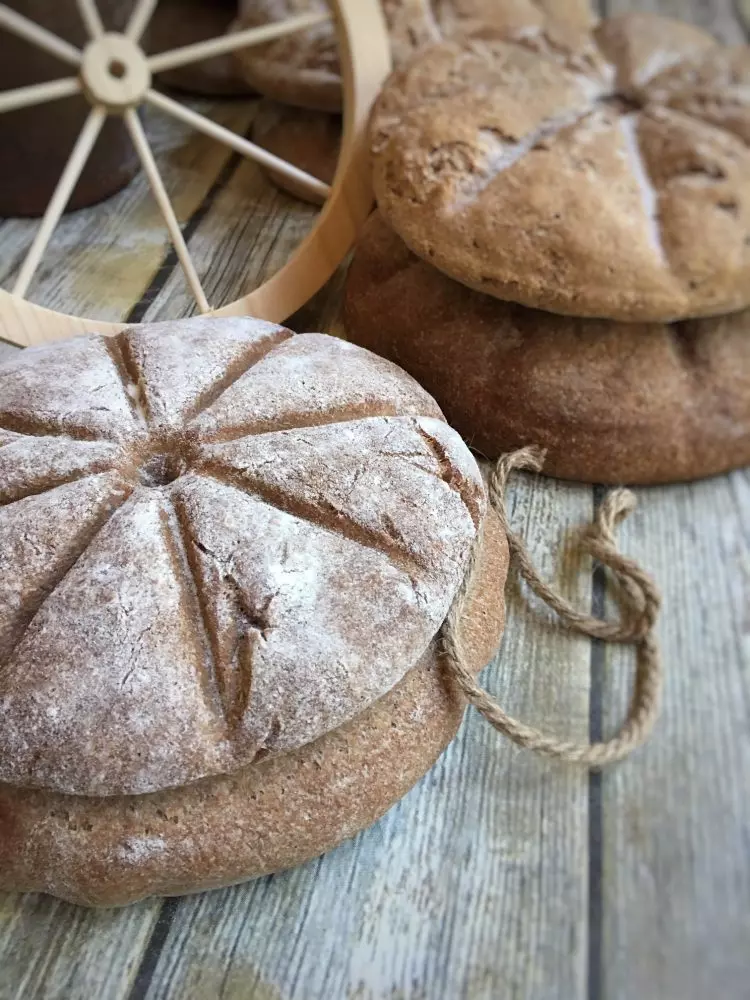
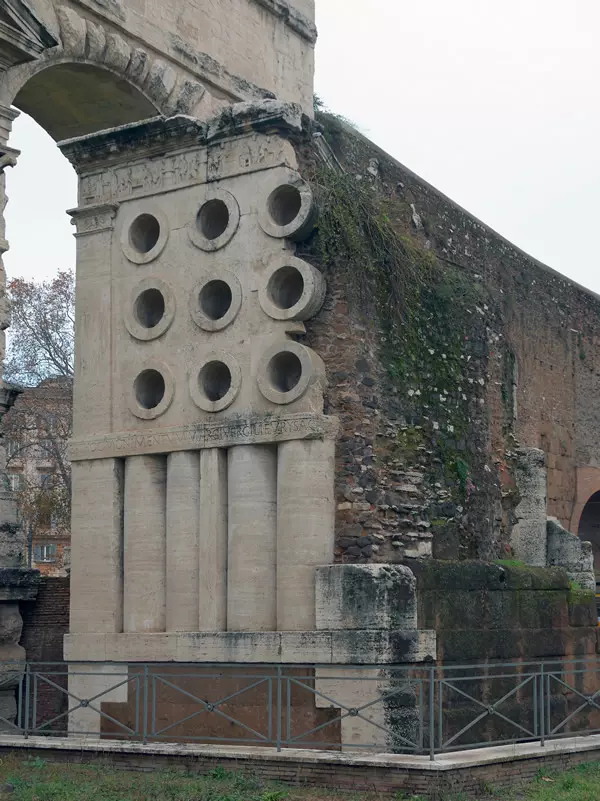
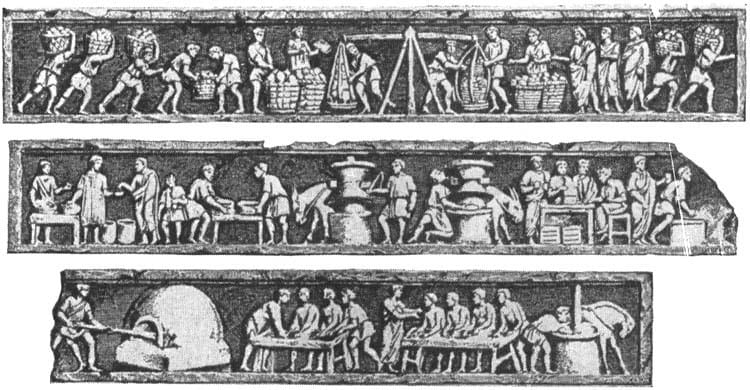
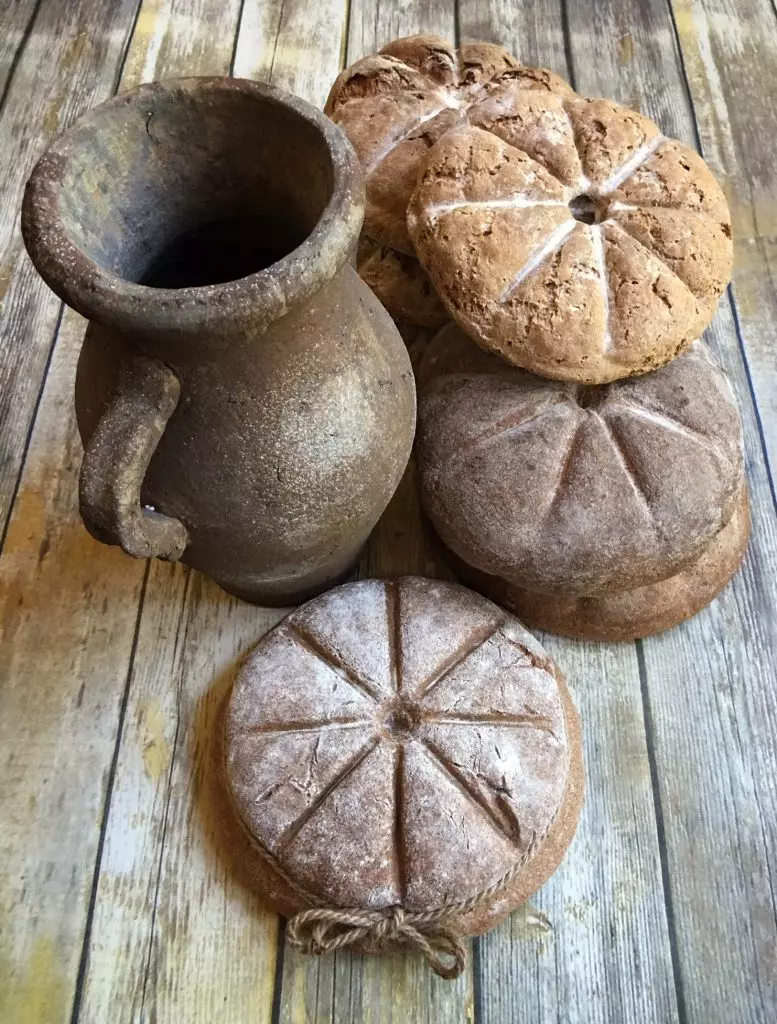
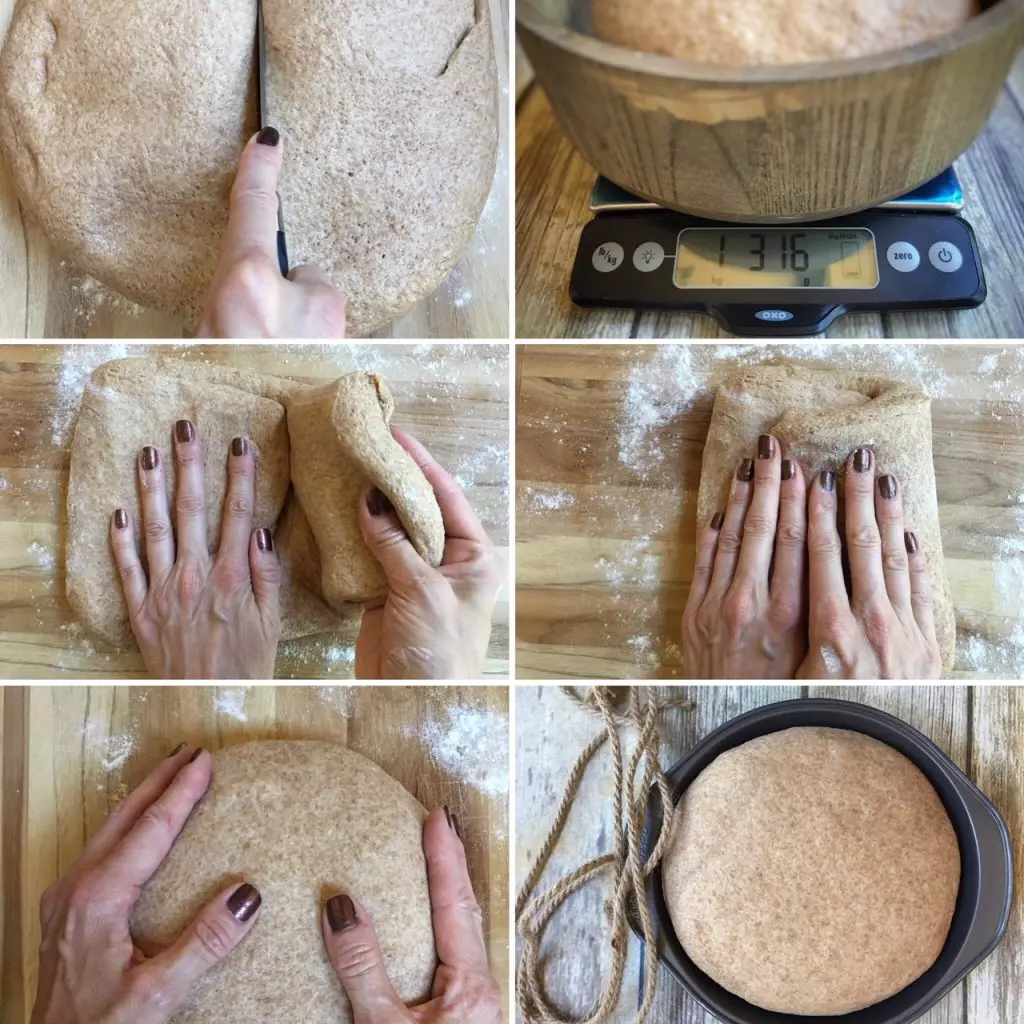
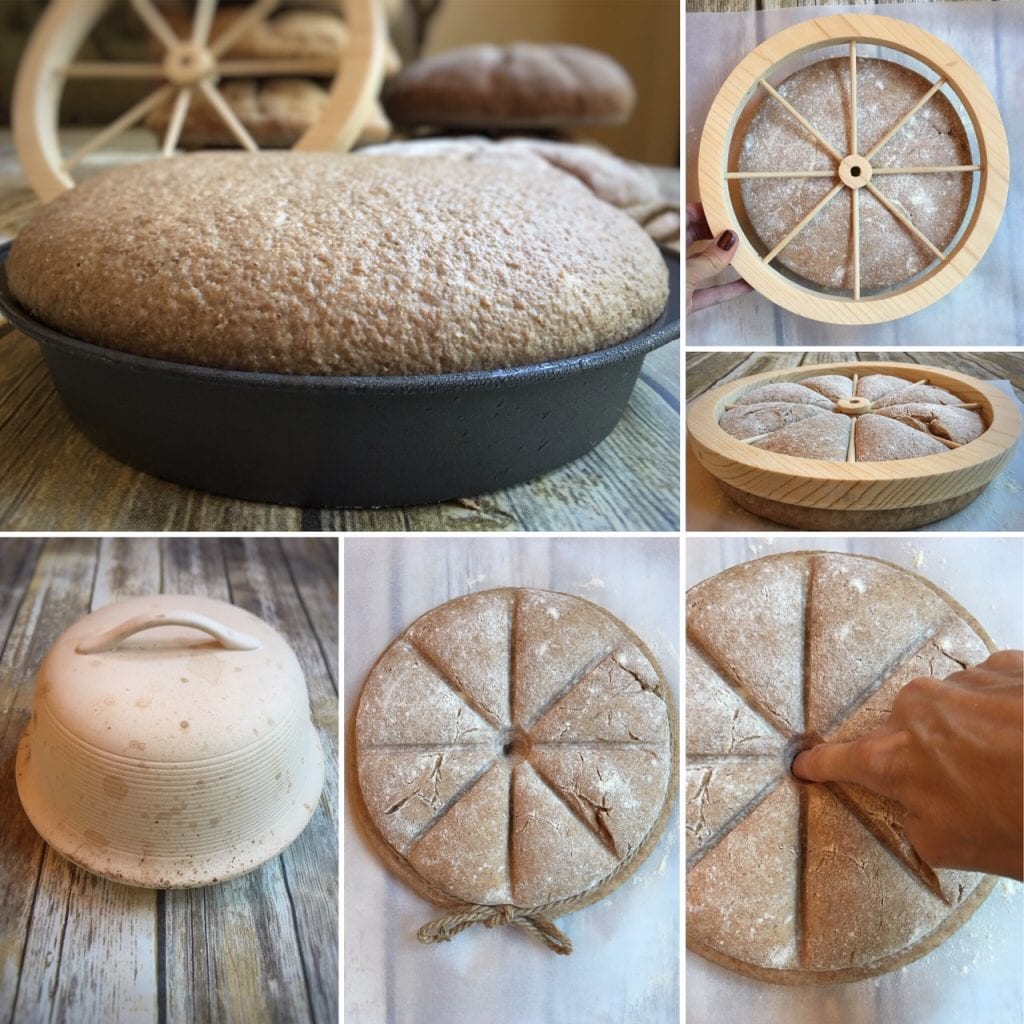
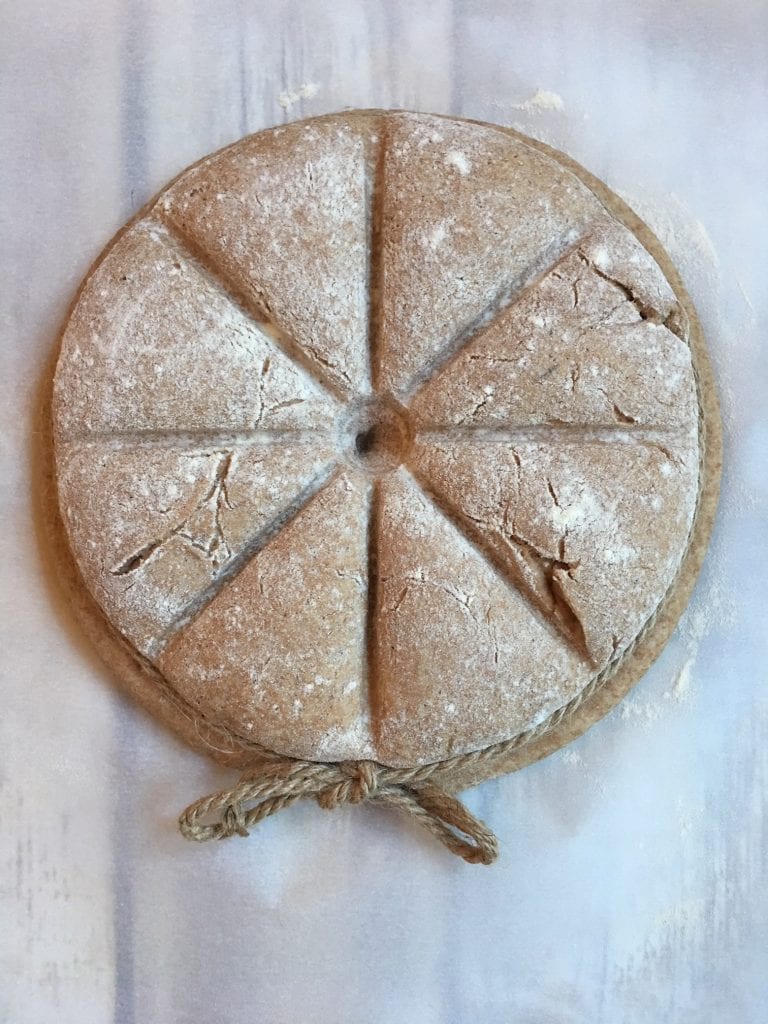


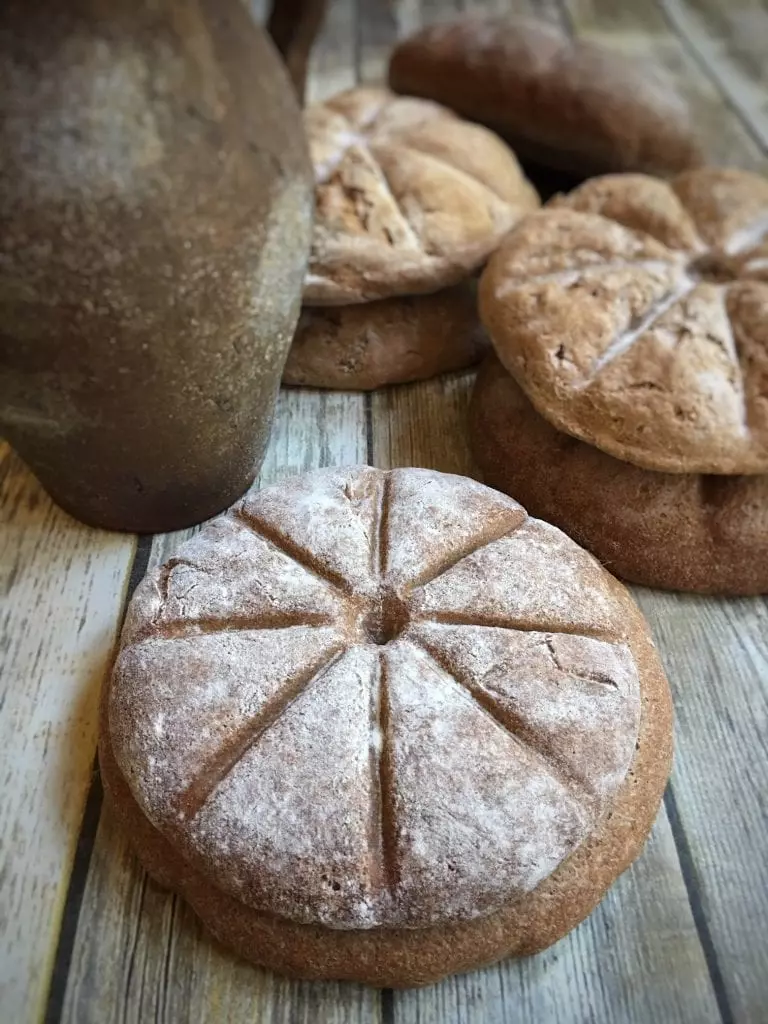




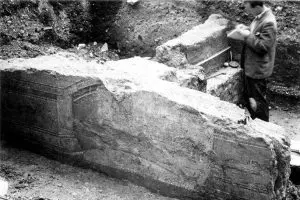


The string tied round the circumference meant that after baking, you could simply securely hang dozens of loaves by their string ends onto a horizontal pole ready for sale. Otherwise you would need a lot of shelf space. Were any racks or poles found in the Pompeii bakers shop?
Hi Steve! See this post: https://tavolamediterranea.com/2019/08/30/baking-with-the-romans-the-key-ingredients-poppy-seed-fennel-and-parsley/
Salve Farrell! Ego sum avidus pistor et cupidus experiri Panis Quadratus.
I have a starter that began in 2019 and is still going strong (it gets regular feedings weekly and the discard is used for pizza dough on Fridays.) I have a quantity of red wheat berries from a family farm in Arkansas and a mill to make my own flour. All I needed to find was Git, which was easily done in a local Indian grocery store.
I started with an earlier version of your recipe that had 8.5 cups of flour (which threw me off as I ALWAYS weigh my ingredients) and I ended up with a HUGE single loaf!!!! Definitely more than a loaf my wife and I can get through, so we quartered the Quadratus and shared it with friends.
I’ve tried it with garum (vietnamese fish sauce, garum-esque) and it is surprisingly good!!! Today I had it with a soup inspired by Apicius: leeks with chickpeas, cumin, white wine, and a touch of olive oil. I ripped the bread into bite sizes and soaked it in the soup. The flavors of leek/cumin/nigella/wheat is simply heavenly!!!!
Thank you for this fascinating and participator glimpse into Roman life!
Thanks for your comment Michael!
I wonder if the dough was risen into a form, rather than pressed afterward.
That would have involved a lot of forms, but this is after all a mature, industrial operation.
It’s not a bad idea, just an impractical one. Yes, a lot of forms that have to be stored when not in use… moved to and fro… etc. Occum’s razor applies here. Simplified production would have made for faster/easier work with less in the way.
I would consider a single “pressing” tool to make the pattern in one action, including the central hole, however.
Yup. There is a wheel proposed in this post. However, its not what you’ll read in the publication due shortly! You are correct that fast and efficient production is key, but so are cheap resources. 🙂
If the segments on top of the loaf are lifted off, the what is left may act as a bowl, for stew/sauce and the segments used as utensils ? Great article. ?
Just brainstorming because the sag in the center is fascinating! Is it possible that the loaves were pressed and indented as you have done, either by wheel or some other wooden tool, but the sag you are seeing is as a result of the incineration in the eruption and not part of the original baking and shaping process? Meaning: the sag was not in the original loaves but the sudden and intense molten heat that not only caused the preservation of the loaves also distorted them in this way? Shall we bake a loaf like yours and toss it into some magma and see what happens to it? Only slightly joking. Can we bake it, let it cool (as though it were on a shelf to be sold,) and then put it back in the oven on high heat and just let it go until it blackens beyond recognition and maybe the pressure created within the loaf as a result of all moisture and steam being sucked out creates a small vacuum that pulls the center of the loaf down and in??? I am all about trying this. Thoughts?
Recently discovered your website and am greatly enjoying it. Just watched an episode of the Great British Baking show, where they made old fashioned cottage loaves and I noticed the similarity to the shape of panis quadratus. The indentation around the middle of the quadratus could be two balls of dough stuck together, and then the indentation on top could be the result of the fingers being stuck down the center to make the two balls of dough stick together. Even the slashes on the top of the dough are similar. Just a thought.
https://britishfoodhistory.com/2020/07/01/a-cottage-loaf/
I find your articles and speculation absolutely fascinating! Thank you for sharing!
Maybe I’m stating the obvious, but since the volcanic eruption started on day 1 (August 24th or maybe October according to the latest research) and continued until early on the next day, we can suppose that the last bread that was baked in commercial ovens was pre-dawn on day 1, and was stashed in the oven you mentioned previously for safekeeping as the bakers sought refuge? Were any loaves found elsewhere in the city or in that particular oven only?
Hello! I met the division of bread into recesses before baking, for example, in oriental bread. Look “Churek” – this is the name of bread in the North Caucasus or “Matkanash” – this is Armenian bread. In this case, the baker makes the grooves using the edge of the palm or fingers.
Strips are needed in order to divide a piece of bread evenly and without a knife (can this be important for slaves who could not own a knife? Or is this a usual convenience for a regular feast). In addition, bread from Pompeii can be sold or distributed in equal parts, which is convenient and fair.
Lana, this bread is beautiful! Isn’t it wonderful to consider the similarities in bread-making between cultures? – Farrell
Is the cooking time the same if I were to make a smaller version (eg with 1/3 of the ingredients)? This looks to be the most comprehensive recipe for panis quadratus!
If you’re going to make a smaller version, check it around the 45 minute mark. You’re looking for a nice dark/golden brown crust and a well-baked interior. And thank you! Yes it is. I have been researching this for years. There’s a paper on this being published shortly as well… lots of surprises in store! – Farrell
Really appreciate this site and all the info. Many thanks
Thank you Ronnie!! – Farrell
Or this could just be regular cross made with two sticks, with some nail/stick in the middle, that you press it in the dough, and as you move this cross around to make four and then eight parts, you unintentionally pull the dough in the middle to form this middle uneven mark.
Or one stick?….. 🙂
Hello. I’m in the middle of baking this bread and reading your articles, and I’m wondering if this lines could be made from stacking some form of proofing baskets/racks/trays (with the bottom as your wooden wheel but not hollow) on top of each other, to save space in the bakery. That implies flatter bread, wider bread in the bottom, eight parts, and similar shape of bread in bakeries around.
I’m pretty sure your replica of this wooden wheel is more accurate than that of the wagon on the picture. If a wheel of a pictured wagon would broke, they have to replace the whole wheel. But if it’s made as your replica, they can change axle and all eight ‘sticks’ one by one.
Also the bottom of taditional baskets are made with two crosses, around which you intertwine willow, so that’s eight parts. But then you could see traces of intertwined willow on the dough too.
Hi Mojca! Which baskets are you referring to? Have you seen any in the Roman archaeological record? That’s a great theory in that it’s space efficient as well. – Farrell
This site is AWESOME! I recently discovered it awhile ago and dismissed it as a critique on ancient foods, what they might have tasted like etc. It wasn’t until i had some time to spend that I began to look at it seriously. My interest in the ancient Romans and Greeks has stayed with me since childhood. Around 40 years ago I acquired a copy of the ‘Roman Cookery Book’ by non other than Apicius, translated by Elizabeth Flower & barbara Rosenbaum in a used bookstore. I really lucked out on that one. Living in San Francisco I’ve always been a fan of sourdough bread since childhood. Over the years I’ve tried to make my own starter from unsulfured wine grapes using nancy Silverton’s recipe. She appeared on the late Julia Child’s PBS series ‘baking with Master Chefs’. Anyway that didn’t work so i used potato water from boiled potatoes cooled of course, set out in a large mason jar with a piece of paper towel over the top to prevent dust and bugs. After a few days i noticed it had a few bubbles and was a bit fizzy so i added a bit of unbleached flour, stirred it up and set it out again for a day or so, then it really took off. I started with about 2 cups of potato water and the forst ‘feed was about 1/4 cup unbleached flour. the second feed another 1/4 cup flour etc until I had a starter with the consistency of pancake batter. I then used 1/2 ro make pancakes, no use throwing it away. I then added 1/2 volum spring or bottled water and an equal amount of unbleached flour. It’s important to use bottled water in your starter when doubling up for baking. So far so good. When not in use store the starter, labeled so it doesn’t accidently get thrown away in a Bocal, the type of large canning jar with the wire bail and glass lid, without the rubber gasket.in your fridge. Since a starter is alive and fermenting, if it’s sealed up tight, it could explode making a mess of tour fridge. When reading to the recipe for these Roman breads, the quantities were large and i was wondering if they can be halved with the same success? If you could post your response, this might also help others who have the same concern. Once again, your website is AWESOME
Thanks William! That potato starter sounds pretty amazing! – Farrell
I’m thinking the central indentation would be a good receptacle for olive oil, allowing it to soak-in prior to breaking the bread into sections for eating.
I’m thinking the center hole may be a place to dig your thumb in, to facilitate tearing a triangle out of the loaf.
A quick question about the hydration level. The water quantity in the recipe (1.25kg water to 2.2kg flour) gives a hydration of about 57%, but later you say that they dough is about 40% hydration. I can happily wrangle quantities if needed, but if you can say which is closer to correct that would be helpful to stop me reinventing the (bread) wheel.
Hi Clare! You’re correct. It’s 55%. I’ll correct that! Thanks for pointing it out. 🙂 – Farrell
Possibly addressed before but, could the collapse be caused by over-proofing? If the bread was abandoned before it could be intentionally baked, the rise might have continued until the yeast exhausted itself. Then the loaf would have collapsed.
Great theory! Here’s the thing though: 81 of these loaves were left in an oven that is waaaay too small to bake 81 loaves. They were hoarded prior to the eruption. They were already baked. You can tell this from looking at the crumb as well which is leavened and presents with tiny holes just like bread does once it’s fully baked. Thank you for your contribution! – Farrell
I saw a video of the British Museum… an Italian chef, Giorgio Locatelli, who lives in London, also prepared this kind of bread and he explains so many secrets…
https://youtu.be/DYTuNXq1eBk
That’s a great video! Thanks for reading, Alessandra. – Farrell
Salve,andando su e giu per il web mi.sono trovata questo sito,e stupendo e come sono amante del fate il.pane a casa questo.pane dei Romani lo vorrei fare,purtroppo il sito e scritto in Inglese e ora per caso.lo.legho in Italluano,non ho capito il processo del starter,o pasta madre,l’avevo ma el’ho lasciata morire per viaggio,e ricominciare da capo non ho voglia ho letto quello fatto con acqua delle patate mi.potrebbe darmelo.piu preciso Grazie,Linda,o c’e’ un libro su questo.pane Romano in Italiano e come iniziare a prepararlo.
Salve Linda! Certo, ti scrivero un email con piu d’informazione, okay? Ho bisogno d’assistenza con il sito con le pagine italiane. Un studente o qualcuno perche e’ la mia lingua seconda e ho bisogno piu di tempo per tradure le pagine. Dammi un po di tempo… Voglio pubblicare anche il sito in italiano. – Farrell
I cannot visualize the “wheel” as a practical tool in the presented form. A repeated pattern, yes, but I notice the indentations of 4 lines is prominent and many loaves correspond more to a 4 lined tool used twice (8) or thrice (12) than a 8 spoked tool used once. The construction of an 8 spoke wheel especially the center looks weak compared to the stability known to romans at the time. I would propose two cross secting round edged wooden blades with a midde “crossed lap joint.” Two symmetrical pieces, about the width of a finger or more and thinness of approximately 1cm, one reversed over the other. Pressed first once then turned and pressed for a second (or third) time might be more practical, easy to reproduce or replace and more veritile to variation in loaf sizes. Middle indentation could be caused from material wrapped around the center to fix the joint or a type of wooden plumb shaped to keep the two wooden slats together at near perfect right angles and most importantly a combination of the baker’s finger tips in pressing down the form at center. Has this been attempted?
Great theory, Sarah! Can you draw it out though? Come join us on Facebook: https://www.facebook.com/tavolamed/
I would love to try a loaf of this bread. I’m not a Baker but this artical was fascinating. Thank you.
Thank you for reading! Farrell
wondering how the bread tasted? Also – is it possible the sections are for looks? Last I was wondering if the holes might be something to do with stacking bread – I mean the amount being made suggests a lot of rising loaves… Thanks for the article!
Hi – thank you for this; very interesting.
I was wondering: the frescos shown with this entry don’t seem to show the bread as deflated in the middle as the recovered loaves. The recovered loaves were abandoned and so would have been left in the oven too long, and then of course subjected to the extra heat of the eruption. If your modern experiments were over baked and subjected to excessive heat – would they deflate in the middle? Or, are there other frescos that show the loaves more deflated in the middle?
Best wishes in your continued investigation!
Thanks for such a wonderful article and recipe. I keep wondering could the use of the wheel and hole be caused (maybe) by using wheels as a way to transport the bread to the ovens? Rather than pressing the dough with the wheel could the dough have been sat on the wheel, a finger used in the center to stabilize as they moved it to the ovens and then flipped onto the oven floor for cooking? The impact of landing on the oven in such a way might have caused a slight depression in the center of the bread or maybe I am imagining too much.
Superb article, thank you. Could the 8 divisions be a form of portion control, so everyone gets a fair share. As the loaves have a central hole/dent are they transported on poles rather than baskets? https://goo.gl/images/ixh7qa
Hi Paul! I do think that number is significant but am not sure what it reflects. Two wedges per day for an average Roman family? A symbol of something else? It’s certainly worth exploring further. Great idea re: transport but there’s no evidence of a hole on the bottom of the loaf. It could be part of the tool or, as another reader suggested, a hole created so heat could access and could cook the centre of the loaf. Fascinating isn’t it? – Farrell
Hi, what a wonderfully enthralling account. (Found whilst looking for something else entirely – as often happens!) I love a puzzle and this certainly provides a few! Here are my ideas for what they’re worth. Firstly I think the central hole was a clever refinement to facilitate breaking the loaf easily, neatly and therefore most fairly (important in a carefully controlled product). Depressing the dough in the centre before cooking ensures an evenly and more quickly cooked loaf (i.e. saves time, significant in mass production). I’m still puzzling about that name which signifies four. Perhaps it reflects the breaking of the loaf into four pieces each of two sections – which may have been considered enough for the average person (evidence needed of how the bread was served at table). I don’t really think old currus wheels would have been used to mark out the segments since to my admittedly untrained eye the divisions in the dough look too thin and purposefully crafted. I liked someone’s earlier suggestion that a shaped tool could have been pressed four times into the dough. I really would love to get to the bottom of the mysteries of these loaves and thank you again for the article.
From one bread-nerd to another: thank you for one of the most fascinating and compelling “cookbook” entries ever. You combined meticulous research, Roman history, baking, bread, and recipes — some of my favorite topics — into one article! Brava!!
Thanks Alexandria! 🙂 – Farrell
The hole in the center also speeds baking time and helps ensure center gets done too. Thank you for such interesting articles
That’s makes a lot of sense, Sharon! Thank you for reading. 🙂 – Farrell